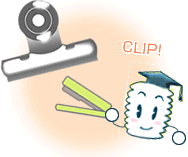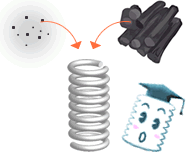
Episode 27: Even Exceeds Einstein's Idea
Hello everyone.
Time really has flown by, hasn't it! Here we are…and already it's the end of the year. If only time were like a spring…
That reminds me, I've heard that Einstein conducted research into the spring of time. But it's very difficult to explain, so I'll leave that discussion to another time. In essence, it seems that he conducted research regarding time warp = time spring.
If you could use the spring of time, what would you do? I think I would try to return to a time when I was younger.
Until now, I've introduced you to a lot of ways and places where springs are used. But I completely forgot about clips!
Most of the time, when you want to keep papers together, you would use a clip or a staple. There are elongated wires that are wrapped to form a metal clip and thin metal plates folded in two to form a clip, and some have two metal wires attached to that you can open up the folded metal plates with your fingers.

Compared to staples, the good thing about clips is that it does not make a hole or damage the paper, and they are convenient in keeping individual sheets from getting loose. Most of the metal clips are made from stainless steel.
Anyway, springs are items that use rebounding force. This rebounding force is elasticity, which is also our company's slogan. That rebounding force is different depending on the amount of force in that material.
If a force that exceeds the rebounding force of that material, that spring will not be able to return to its original shape. This is called plasticity. The spring will become fatigued if a weight is applied that exceeds that limit, or if the limit that the spring can return is exceeded even if that weight is within the spring's limit. Springs can become fatigued if used for a long time.
The other day, my friend asked me, "can springs be made from steel?" Do you know what springs are made from?

Metal springs are often made from steel. This is also used in the cutting portion of a blade. However, this steel originally had to be firm, so springs were made from metal called tamahagane. To make tamahagane, iron sand and charcoal were added to the steel.
If a metal spring is as hard as steel, it will lose its elasticity, so carbon is added to the steel. The hardness of the spring will vary according to the amount of carbon that is added. Most standard springs have 0.02% to 2.14% by weight of carbon added.
But people long ago really were smart. They added iron sand to the steel, and added carbon after burning wood, but before it turned to ashes. You really must respect their knowledge.
This is as far as I can go this time.
Let's work hard, in these last months as well, so we can look back and say it was a good year this year too. Trying hard is good for your health.
See you next time!
Written by Banekko (a child of spring)




